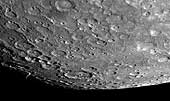|
COMETS EARTH JUPITER KUIPER BELT MARS MERCURY METEORITES NEPTUNE OORT CLOUD PLUTO SATURN SOLAR SYSTEM SPACE SUN URANUS VENUS ORDER PRINTS
PHOTO CATEGORIES SCIENCEVIEWS AMERICAN INDIAN AMPHIBIANS BIRDS BUGS FINE ART FOSSILS THE ISLANDS HISTORICAL PHOTOS MAMMALS OTHER PARKS PLANTS RELIGIOUS REPTILES SCIENCEVIEWS PRINTS
|
Related Documents
Download Options
One week ago, on January 14, 2008, the MESSENGER spacecraft passed 200 kilometers (124 miles) above the surface of Mercury and snapped the first pictures of a side of Mercury not previously seen by spacecraft. This image shows that previously unseen side, with a view looking toward Mercury's south pole. The southern limb of the planet can be seen in the bottom right of the image. The bottom left of the image shows the transition from the sunlit, day side of Mercury to the dark, night side of the planet, a transition line known as the terminator. In the region near the terminator, the sun shines on the surface at a low angle, causing the rims of craters and other elevated surface features to cast long shadows, accentuating height differences in the image. This image is just one in a planned sequence of 42 images acquired by the Narrow Angle Camera (NAC) of the Mercury Dual Imaging System (MDIS). From these 42 images, the MESSENGER team is creating a high-resolution mosaic image of this previously unseen portion of Mercury. In total during the flyby, MDIS took more than 1200 images, which are being combined to create multiple mosaics with different resolutions and of different portions of the planet. The creation of high-resolution mosaic images will enable a global view of Mercury's surface and will be used to understand the geologic processes that made Mercury the planet we see today. This image was acquired about 98 minutes after MESSENGER's closest approach to Mercury, when the spacecraft was at a distance of about 33,000 kilometers (21,000 miles). Mission Elapsed Time (MET) of image: 108830711 Credit: NASA/Johns Hopkins University Applied Physics Laboratory/Carnegie Institution of Washington |
